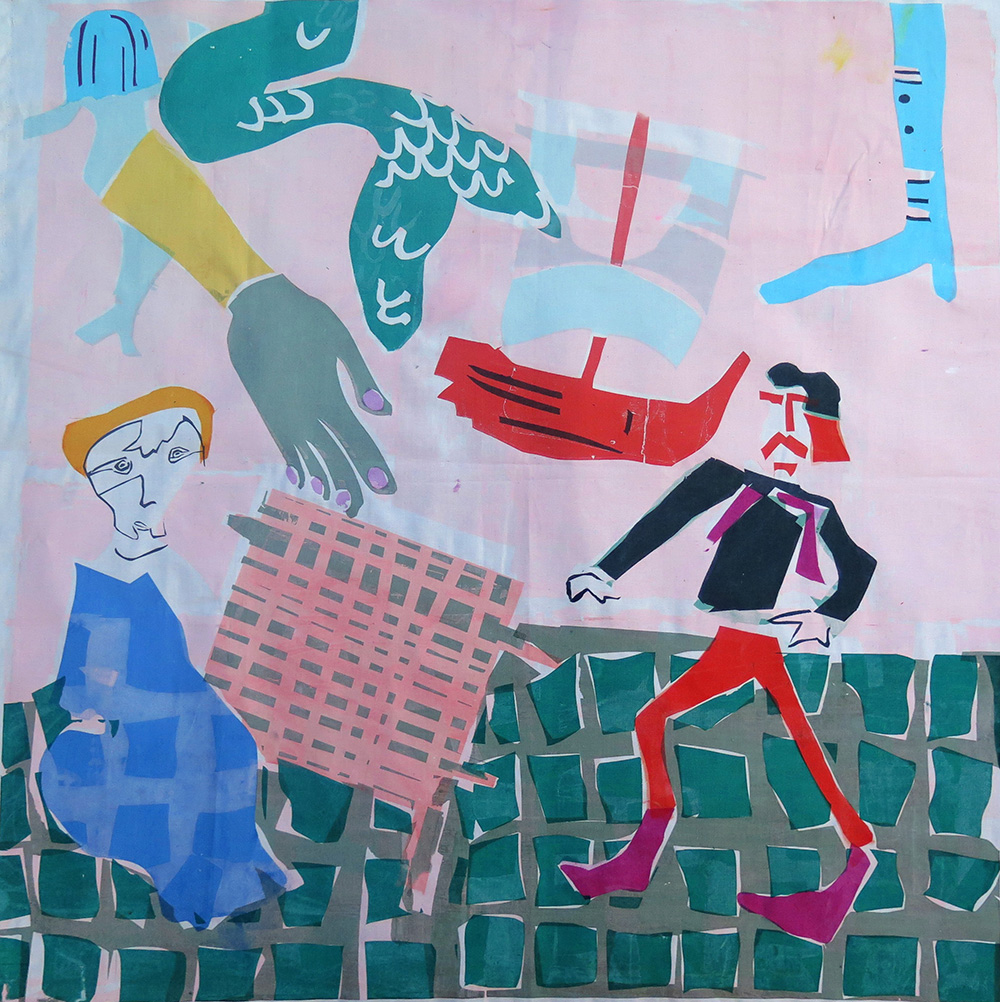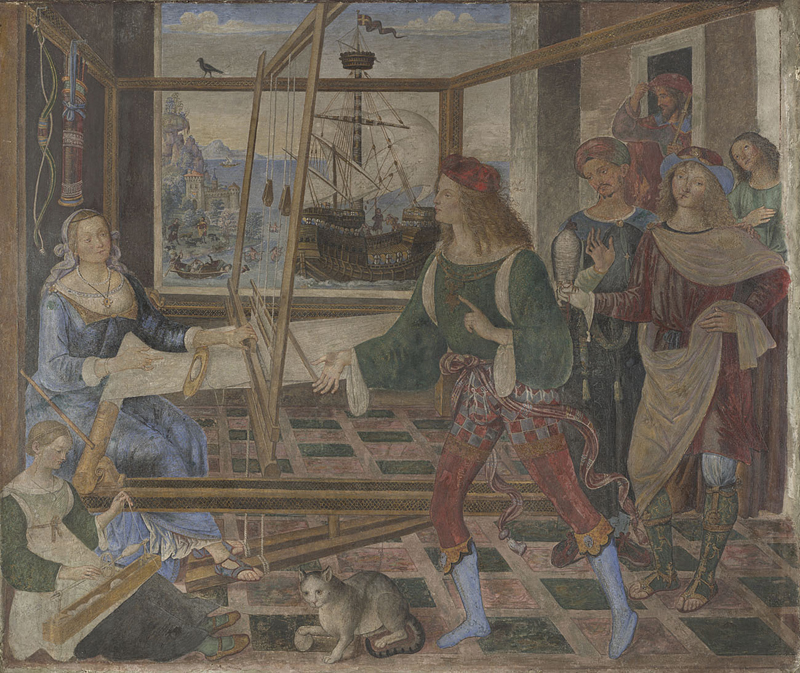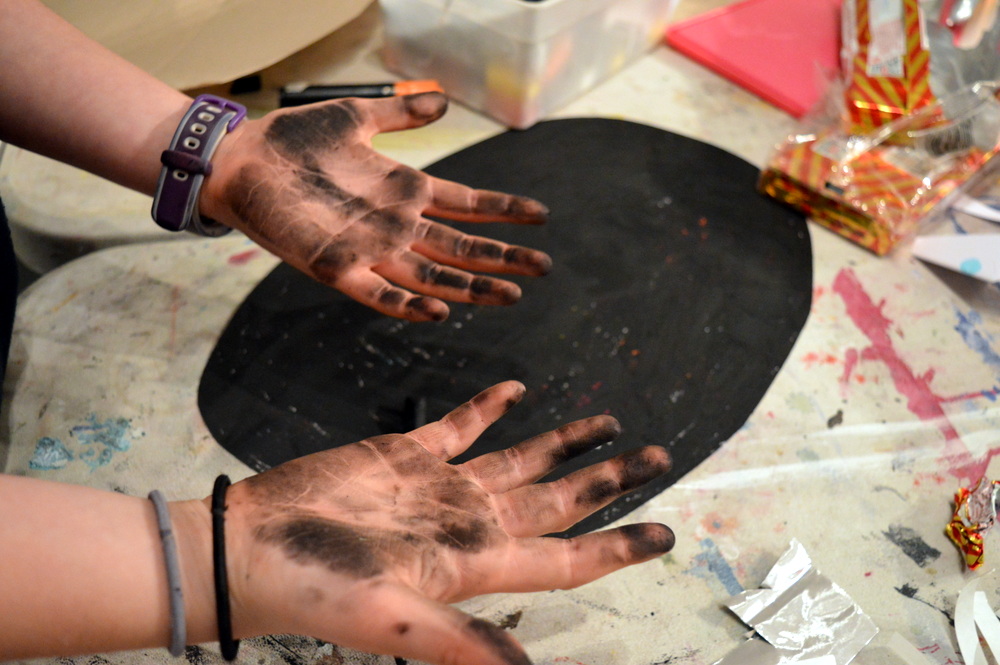By Jan Miller
This resource is part of a collection called Teaching Art to Year Three.
Based around an exploration of an historic painting (Penelope with the Suitors by Pintoriccho), the project shared below presents three activities which develop drawing, collage and printing skills, culminating in a modern interpretation of an old master and the creation of a collaborative artwork.

-
Context
The focus for our artwork was Penelope with the Suitors, 1509 by Pintoricchio, displayed in the National Gallery, London. Participants developed an understanding of symbols as well as story-telling and the painting appealed to the youngsters:
• Penelope weaving at the loom – unpicking the woven cloak each evening to avoid a pledge to marry when completed.
• Suitors trying to impress Penelope in their finest clothes and disguise.
• Wailing sirens in the sea.
• Many hidden symbols such as cat, wool, bird, bow, boats and animals.
• The project began with discussion of what may have happened before and following the scene in the painting. Children looked for symbolic imagery and questioned the meaning.The children wished to make their own modern version of the traditional painting, using simplistic symbols in a bright, modern palette. They questioned the composition: perhaps we could explore sizes with the largest shapes moved to the back. Would it work if we used a small figure and giant boots? Do we need a detailed cat or could we just use symbolic whiskers? Rather than a mermaid, could we just draw create part of the tail?
-
Who are the sessions aimed at?
The sessions were run with children aged 8.
The resources below can be used with children aged 7 to 11 (older KS 1 children and KS 2 children).
-
Which areas of exploration are covered?
• Drawing and mark making (black felt tips/markers).
• Drawing from observation.
• Colour mixing (paint).
• Drawing with scissors.
• Explore scale, composition, negative space, layering & cropping.
• Create a group composition using selected mages.
• Develop a narrative though the symbols.
• Appreciation of historic art.
• Cross curricular links with History and English.
• Using established art to inspire own work.
• Making a shared final piece. -
How much time is needed?
Each of the six sessions took an hour with the whole class.
If you were working with a smaller group of children the activities may take less time. Sketchbooks were available in all lessons to continue research drawing.
The activities progressively built on each other and the children developed an understanding of process.
If you followed all the sessions you would cover the areas of exploration listed.
However, if time is limited, you could complete a smaller body of work in two or three sessions, depending upon your chosen area of interest. The final piece could be the collaboration of the coloured paper designs. The teacher could complete more of the preparation, such as making the painting papers or using supplied coloured paper. Smaller compositions could be made with the work of a couple of children or each table. Stencils could be drawn and cut out directly from the drawings.
A different painting could be used as stimulus.
-
Where might the sessions be used?
• Classrooms (as part of art lessons or workshop)
• After school art club or AG&T group.
• Community groups (i.e. Scouts and Guides)
• Gallery, Museum or Art Organisation workshop. -
Materials and Equipment
– Poster paints and white emulsion.
– Marker pens
– Scissors
– Newsprint
– Screens for printing
– Acrylic and screen extender
– Squeegee
– 1m fabric.
– Craft knife/cutting board (gyro cut- a safer method of cutting paper shapes)
The focus for our artwork was Penelope with the Suitors, 1509 by Pintoricchio, displayed in the National Gallery, London. Participants developed an understanding of symbols as well as story-telling and the painting appealed to the youngsters:
• Penelope weaving at the loom – unpicking the woven cloak each evening to avoid a pledge to marry when completed.
• Suitors trying to impress Penelope in their finest clothes and disguise.
• Wailing sirens in the sea.
• Many hidden symbols such as cat, wool, bird, bow, boats and animals.
• The project began with discussion of what may have happened before and following the scene in the painting. Children looked for symbolic imagery and questioned the meaning.
The children wished to make their own modern version of the traditional painting, using simplistic symbols in a bright, modern palette. They questioned the composition: perhaps we could explore sizes with the largest shapes moved to the back. Would it work if we used a small figure and giant boots? Do we need a detailed cat or could we just use symbolic whiskers? Rather than a mermaid, could we just draw create part of the tail?
The sessions were run with children aged 8.
The resources below can be used with children aged 7 to 11 (older KS 1 children and KS 2 children).
• Drawing and mark making (black felt tips/markers).
• Drawing from observation.
• Colour mixing (paint).
• Drawing with scissors.
• Explore scale, composition, negative space, layering & cropping.
• Create a group composition using selected mages.
• Develop a narrative though the symbols.
• Appreciation of historic art.
• Cross curricular links with History and English.
• Using established art to inspire own work.
• Making a shared final piece.
Each of the six sessions took an hour with the whole class.
If you were working with a smaller group of children the activities may take less time. Sketchbooks were available in all lessons to continue research drawing.
The activities progressively built on each other and the children developed an understanding of process.
If you followed all the sessions you would cover the areas of exploration listed.
However, if time is limited, you could complete a smaller body of work in two or three sessions, depending upon your chosen area of interest. The final piece could be the collaboration of the coloured paper designs. The teacher could complete more of the preparation, such as making the painting papers or using supplied coloured paper. Smaller compositions could be made with the work of a couple of children or each table. Stencils could be drawn and cut out directly from the drawings.
A different painting could be used as stimulus.
• Classrooms (as part of art lessons or workshop)
• After school art club or AG&T group.
• Community groups (i.e. Scouts and Guides)
• Gallery, Museum or Art Organisation workshop.
– Poster paints and white emulsion.
– Marker pens
– Scissors
– Newsprint
– Screens for printing
– Acrylic and screen extender
– Squeegee
– 1m fabric.
– Craft knife/cutting board (gyro cut- a safer method of cutting paper shapes)
Week 1 Drawing Objects that Feature in the Painting
With marker pens on large newsprint paper, pupils drew objects that they identified as key features in the painting which they studied.

Penelope with the Suitors
about 1509
Fresco, detached and mounted on canvas, 125.5 x 152 cm
Bought, 1874
NG911
This painting is part of the group: ‘Three Frescoes from Palazzo del Magnifico, Siena’ (NG910-NG911; NG3929)
https://www.nationalgallery.org.uk/paintings/NG911
They used props from the Drama department for observation and children also resourced objects and took photos themselves as reference such as plastic animals, boots, hat, toy ship, wool, bow and arrow, weaving shuttle and costumes. Some used printed images as sources including a bird, loom and mermaid. A continuous line was encouraged, to create an expressive style. No pencils or erasers were allowed.
To access all content, I would like to join as…
AccessArt is a UK Charity and we believe everyone has the right to be creative. AccessArt provides inspiration to help us all reach our creative potential.

